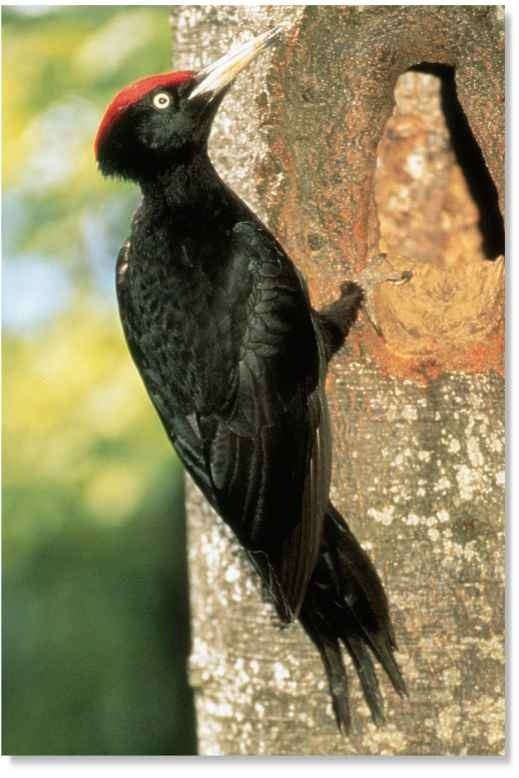ORDER
Piciformes
FAMILY
Picidae
GENUS & SPECIES
key features
• Attracts a mate or sends a signal by drumming a rapid sound called a “tattoo” with its beak
• To guard against predators, it makes a “doorway” in a tree just large enough for an adult woodpecker to pass through
• Feeds its chick by prodding a “facial knob” that makes the chick open its mouth
where in the world?
Throughout Europe and Asia; south into Spain and France, north to Norway, Sweden and Finland, across central Asia, east to Japan and southwest china

LIFECYCLE
The black woodpecker was an accomplished percussionist long before drumsticks and drums were invented; its steady tap and drilling noises reverberate through the forest.
HABITAT
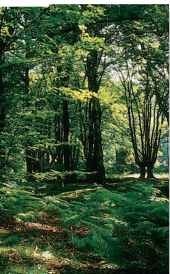
Woodland home A black woodpecker can be heard drilling in the forest.
# The family name Picidae comes from the Roman god Picus, who was changed into a woodpecker by the sorceress Circe.
The head and neck muscles of a woodpecker absorb the shock of 8,000-12,000 pecks a day.
# Internally, the woodpecker’s tongue wraps around the skull before protruding into the mouth.
The nonmigratory black woodpecker commonly inhabits mixed forests, though it frequents both coniferous and deciduous. It excavates its nests mainly in large aspen or pine trees, chipping away with powerful blows of its beak. As the woodpecker works, flying debris begins to pile up in and around the hole.The busy bird stops periodically to remove billfulls of wood particles from the deepening hole, sending them tumbling to the ground directly below. As the nest is nearing completion, only the woodpecker’s tail is visible from the hole, with wood chips flying out behind it. Unfortunately the pile of chips accumulated at the base of the trunk sends a signal to predators that a nest has been built directly above.
The constant drilling by the black woodpecker for nesting and feeding purposes often leaves a dying tree with a pockmarked appearance. Most of the damage, however, is caused by the wood-boring insects that the woodpecker feeds on. The woodpecker’s work is almost invisible until the tree dies from insect infestation.Then the bark peels off, revealing thousands of insect-extraction sites.
FOOD & HUNTING
Tapping a tree with its long bill, the woodpecker detects the small, hidden tunnels made by destructive wood-boring insects. The black woodpecker’s acute hearing picks up the slightest sounds made by the insect larvae as they gnaw and move within the tree. With pickaxlike blows, the woodpecker excavates and then extends its tongue to locate the edible morsels. Sensitive nerve endings guide the woodpecker’s spear-tipped tongue to the tasty insects, which stick to it and are removed from their hiding place. The woodpecker also picks up insects from the surface of the tree. In the spring, it seeks a different snack — tasty sap. In addition to its importance in locating food, the rapping “tattoo” of the black woodpecker also helps define its territory. The drumming noises are used to communicate with the woodpecker’s mate, as well; quieter sounds are exchanged during nest preparation and incubation of the eggs.
a piercing pursuit
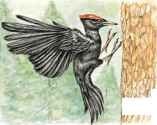
I An undulating flight…
Flying in small, wavelike movements, the woodpecker slows its approach, in preparation for landing, by swooping upward.
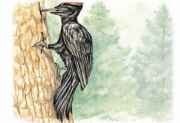
2 A pressing situation…
Eager to find food, it begins chiseling a deep hole in the trunk. Its tail presses against the tree, acting as a brace.
BEHAVIOR
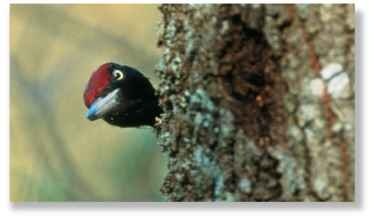
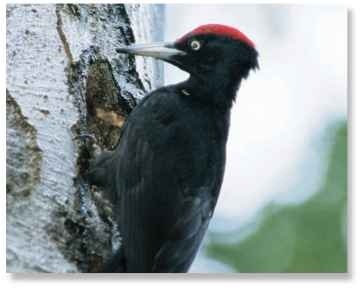
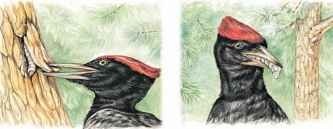
3 A spry pry…
With its bill, the black woodpecker lifts a large piece of bark from the tree to get to the large white grub hidden inside.
4 Tasty “grub”
With the aid of its long tongue, the black woodpecker catches the insect larva and swallows it whole.
Outside of the breeding season, the black woodpecker lives alone. It carves holes used for sleeping, called dormitories, with the male excavating new holes more frequently than the female. Both sexes steadfastly defend their separate territories.At dawn the woodpecker ventures from the dormitory and occasionally fights with rivals along territorial borders. During incubation and fledging, the woodpecker maintains a close watch and defends the nest hole.
Short break
A black woodpecker glances around after drumming its unique “tattoo” of over 30 taps in under three seconds.
BREEDING
As the nesting season nears, each pair decides which of their two prepared nests to use. Both the male and the female live throughout the year in holes carved specifically for solitary sleeping. The male’s hole is usually better constructed, and the female bird frequently prefers it to her own for nesting. The female lays 3-5 white eggs on a bed of loose wood chips at the bottom of the nest. Both parents take turns incubating, but the male spends the night in the nest hole, while the female sleeps in her separate sleeping hole. After 12-17 days, the hatchlings emerge with pink, naked skin and closed eyes. The parents take turns feeding the nestlings. Using their bills they prod facial knobs (projecting folds of skin) at the corners of the youngs’ mouths.The hatchlings then open their mouths to receive regurgitated food. As the chicks grow, they climb the nest’s walls and light for the top spot; the first one at the “doorway” is the first to eat.The nestlings excrete feces into diaperlike sacs that the parents remove to keep the nest clean.

A Very hungry
A nestling almost swallows its parents bill.
conservation
Current populations of the black woodpecker are stable, despite loss of habitat. Occasionally damaged trees are chopped down because woodpeckers are believed to have destroyed the trees with their nests and pecking.
PROFILE
Black Woodpecker
The black woodpecker, clinging tenaciously, appears to defy gravity while it drills into trees — quite a feat for the largest European woodpecker.

CREATURE COMPARISONS
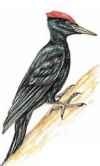

Unlike many colorful woodpeckers, the black woodpecker and Guadeloupe woodpecker (Melanerpes herminieri) blend into the dark reaches of the forest.
The black woodpecker is entirely black except for the bright red on the head and/or nape. The Guadeloupe woodpecker is entirely blue-black, except for a splash of red on its breast and belly At 3.5 oz. and 9.5″, the Guadeloupe woodpecker weighs one-third as much and stands half as tall as the black woodpecker. The Black Guadeloupe Guadeloupe woodpecker lives only in the humid
woodpecker woodpecker forests of Guadeloupe Island in the West Indies.
| vital | |
| statistics | |
| Weight | 9-12 oz. |
| Length | 17.5-19″ |
| WlNGSPAN | 25-27″ |
| Sexual \ Maturity | About 1 year |
| Breeding .. [ Season | March-May |
| Number [ of Eggs | 3-5 |
| Incubation Period | 12-17 days |
| Fledging Period | About 4 weeks |
| Breeding ( Interval | 1 year |
| Typical [ Diet | Wood-boring insects, tree sap |
| Lifespan | Up to 4 years |
Related species
• The six families of the order Piciformes include honeyguides, puffbirds, barbets and toucans. The woodpecker family, Picidae, contains more than 200 species. The seven species in the genus Dryocopus include the black woodpecker, as well as the pileated woodpecker, Dryocopus pileatus. Found in North America, the pileated woodpecker is black with a red crest.
